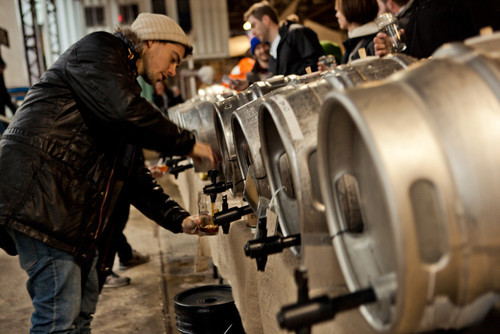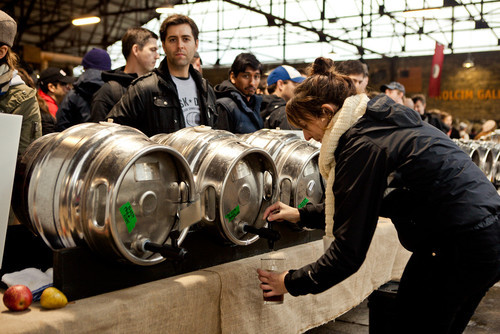Cask Conditioned Ale – The Basics.

By: Kavi Guppta (@kaviguppta)
The explosion of craft beer onto the bar and dining scene has only fueled excitement about unique brews popping up all over the country—add to this the growth in awareness of cask-conditioned ale—Canadians are quickly becoming savvier beer drinkers. With increased recognition, passionate supporters are quick to point out that cask-conditioned ale isn’t merely a style, but an attentive brewing process.
Cask-ale’s rise in popularity has been aided in part by the distinct method it is brewed and served—unfiltered and unpasteurized beer, served from a cask (originating from the Spanish word cascara, which means container)without the use of external nitrogen or carbon dioxide pressure. Its increase in consumption can be associated with a number of defining qualities: a living, breathing product from brewery to pint glass, localized creation to ensure optimal freshness, and an extensive range and depth in flavour that increasingly pairs well with food.

To understand what sets cask-ale apart from other brewing types, we have to explore the history associated with the beverage. For this, we turn to Britain—a country synonymous with its ales and beers. Long responsible for the culture’s evolution and savior in times of conflict, cask-ale worked in Britain because of an enthusiasm among drinkers dating back to the middle ages, but also a cooler climate that allowed the specialized brewing process to flourish. Connoisseurs will claim cask-ale to be Britain’s greatest contribution to the world—it is their staunch attention to detail that has kept cask-ale brewed and served to explicit standard—and the drink has navigated Britons through war, disease, and social progress.
What differentiates cask-ale from keg served beer is the primary fermentation process—the beer is left in the cask to condition naturally right up to the point it is served. Beer destined for cask is “racked” (poured) into the barrel in its natural state, where keg and bottled beers can be sterile-filtered, pasteurized, or both. Finings, substances that remove organic compounds to improve clarity or adjust the flavour and aroma, are added to the beer near the completion of the brewing process. This encourages the yeast to sink to the bottom and remains undisturbed while the beer is poured.

The length of time the beer can last in the cask depends on the nature of the beer itself—but to enjoy the brew at its finest, cask-ale should be consumed within two to three days of being tapped. A wooden peg is knocked into a wooden or plastic fitting called the shive found in the side of ale casks. The wooden peg in the shive allows any extra gas within the cask to vent off. When the beer is deemed ready, the soft wooden peg is replaced with a hard one that doesn’t allow air to flow in or gas to leak out. The beer settles for twenty-four hours, until it is ready to serve. A gravity dispense remains the simplest method of serving types. Once tapped, the cask can allow beer to flow freely into your glass. The cellarman will ensure that the brew is properly vented—allowing air to enter and replace the dispensed beer.

If the beer is sitting in a cool cellar below the pub, a hand pump known as a beer-engine is used to siphon the ale up. Once the lines have been washed, and the beer engine is tapped, the pump requires several pulls to clear air or water. Experienced staff will serve a pint with long, smooth, and slow pulls from the pump handle—resulting in a good amount of head, and beautiful clear ale best poured in a wide-brimmed glass to enjoy its full aroma.
The brewing of cask-conditioned ale is a storied process spanning many centuries. As history has ebbed and flowed, the way we’ve enjoyed beer has also been taken on a wild journey—but Canadians are once again turning to local, artisanal producers of food and beverage, with Cask Days continuing the passion and enthusiasm for this specific brewing technique. The result is an ever-growing community of brewers and advocates championing a community approach to brewing tasty, handcrafted beer made with the utmost attention to detail.
Photo’s by: Connie Tsang
Notes
caskdays-blog posted this








